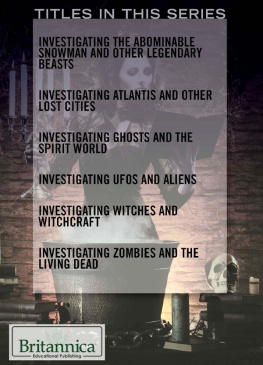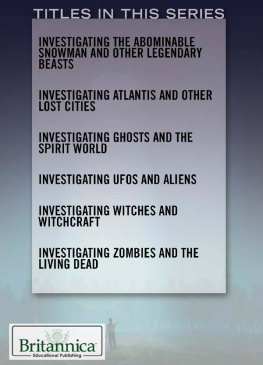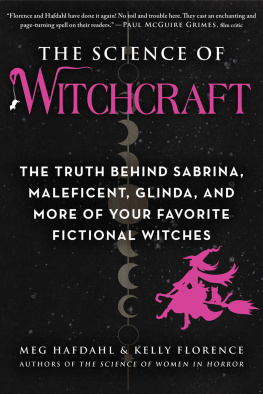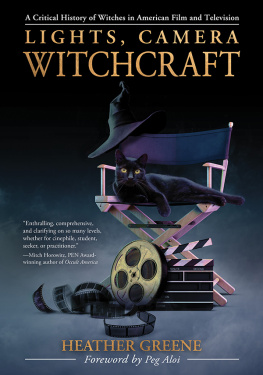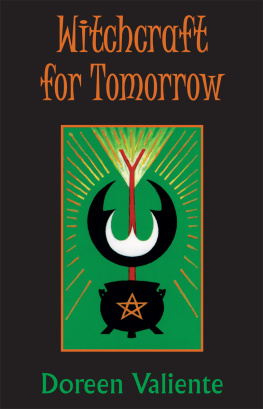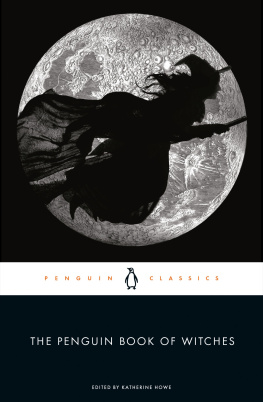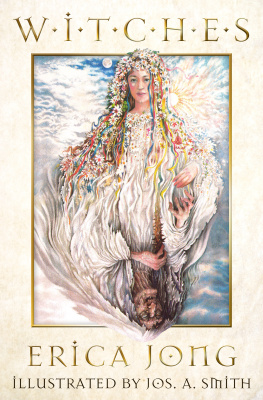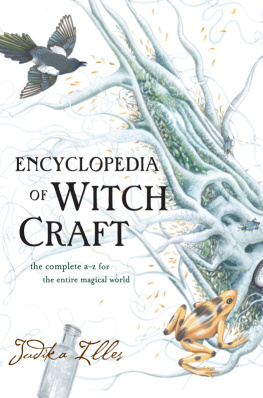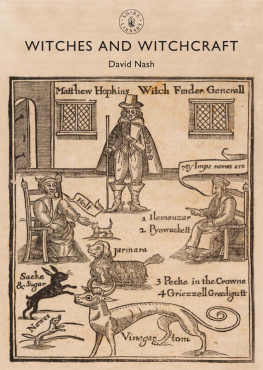
Published in 2015 by Britannica Educational Publishing (a trademark of Encyclopdia Britannica, Inc.) in association with The Rosen Publishing Group, Inc.
29 East 21st Street, New York, NY 10010
Copyright 2015 The Rosen Publishing Group, Inc., and Encyclopdia Britannica, Inc. Encyclopdia Britannica, Britannica, and the Thistle logo are registered trademarks of Encyclopdia Britannica, Inc. All rights reserved.
Distributed exclusively by Rosen Publishing.
To see additional Britannica Educational Publishing titles, go to rosenpublishing.com.
First Edition
Britannica Educational Publishing
J. E. Luebering: Director, Core Reference Group
Anthony L. Green: Editor, Comptons by Britannica
Rosen Publishing
Hope Lourie Killcoyne: Executive Editor
Heather Moore Niver: Editor
Nelson S: Art Director
Nicole Russo: Designer
Cindy Reiman: Photography Manager
Karen Huang: Photo Researcher
Library of Congress Cataloging-in-Publication Data
Shea, Therese.
Investigating witches and witchcraft/Therese Shea.First Edition.
pages cm.(Understanding the paranormal)
Includes bibliographical references and index.
ISBN 978-1-6227-5880-7 (eBook)
1. Witchcraft. 2. Witches. 3. Wicca. I. Title.
BF1566.S445 2014
133.43dc23
2014024103
Photo Credits:
Cover, p. 1 Maksim Shmeljov/Shutterstock.com; p. 5 MGM Studios/Moviepix/Getty Images; p. 7 Walt Disney Pictures/Entertainment Pictures/ZUMA Press; p. 8 New Line/WireImage/Getty Images; p. 10 Frank and Frances Carpenter Collection/Library of Congress, Washington, D.C.; p. 13 Photos.com/Thinkstock; p. 14 ClassicStock.com/SuperStock; pp. 17, 19 De Agostini Picture Library/Getty Images; p. 20 The Bridgeman Art Library/Getty Images; p. 22 MPI/Archive Photos/Getty Images; p. 25 Xavier Arnau/Vetta/Getty Images; p. 27 Photononstop/Superstock; p. 28 Stubblefield Photography/Shutterstock.com; p. 30 Kirk Condy/The Image Works; p. 31 Erin Paul Donovan/age fotostock/Getty Images; p. 33 David Q. Cavagnaro/Photolibrary/Getty Images; pp. 3637 Warner Bros. Entertainment. All rights reserved/Courtesy Everett Collection; p. 38 Kittisuper/E+/Getty Images; p. 40 Walt Disney Studios Motion Pictures/Courtesy Everett Collection; p. 42 Liquidlibrary/Thinkstock; interior pages background images iStockphoto.com/Kivilvim Pinar, iStockphoto.com/mitja2.
CONTENTS
M any young people are first introduced to the world of witches with the famous line from the movie The Wizard of Oz: Ill get you, my pretty, and your little dog, too! The line is uttered by the Wicked Witch of the West. With her green skin, pointy hat, and magical powers, she has many characteristics that people think of when they imagine witches.
But stories of witches and witchcraft were around thousands of years before this 1939 movie and the book upon which it is based. In fact, witchcraft, or rather the belief in it, has shaped some major events in history, often at a terrible cost in human lifeas illustrated by the European witch hunts and the Salem witch trials.
Witchcraft is not, however, a practice only from history and fiction. Some cultures around the world still believe in witchcraft today. There is also a modern Western movement called Wicca that embraces some benevolent (kind and helpful) aspects of the magical art.

The actress Margaret Hamilton became famous for her portrayal of the Wicked Witch of the West in The Wizard of Oz . Hamilton is shown here in makeup and costume.
F rom the Wicked Witch of the West to the many witches of the Harry Potter series of books and films, there are numerous examples of good and bad witches in literature, movies, and other parts of popular culture. Though creations of someones imagination, all these shape peoples ideas of what witchcraft is. However, the stereotypical image of a cackling old woman flying around on a broomstick has little to do with the historical or modern practice of witchcraft.
WHATS WITCHCRAFT?
Witchcraft refers to the activity of witches: people alleged to use supernatural powers in the form of magic to influence people or events. The term sorcery has long been synonymous with witchcraft in the English-speaking world. Nevertheless, some scholars distinguish witchcraft from sorcery by noting that witches are usually regarded as possessing natural magical powers, whereas sorcerers are ordinary people using learned techniques.
Other scholars, noting that modern witches claim to learn their craft, suggest that sorcerys intent is always evil and that of witchcraft can be either good or bad. Historically, some people feared witches, believing their powers stemmed from the devil or evil spirits. Today, in Western popular culture and especially in childrens literature, the sorcerer often has a positive character, while witches are often malevolent, or evil.

Tilda Swinton portrays the White Witch in the film The Chronicles of Narnia: The Lion, the Witch and the Wardrobe , which is based on the book by C.S. Lewis.

Gandalf, the good wizard of The Hobbit and The Lord of the Rings books and movies, is just one of the many magical beings, both benevolent and malevolent, of Middle-earth. The live-action film version of Gandalf is played by Ian McKellen, pictured here.
Witches are often described in Western books and movies as being women, especially old women. However, people practicing or accused of practicing witchcraft have included both women and men of various ages.
WHATS A WARLOCK?
Warlock is one name for a man who practices witchcraft. The term may come from the Old English word waerloga, meaning oath-breaker, which is why it is not a term often used positively. Male witches are also sometimes called sorcerers or wizardsor simply witches. Wizard comes from a word meaning wise. Some people use the label warlock to mean a wizard with stronger and more complex powers.
WITCH POWERS AND METHODS
Lets look at the powers associated with witchcraft and what it means to influence people and events. Witchcraft has been thought to control death and disease, feelings of love and hate, crop failure and success, and the weather. Although some events attributed to witchcraft might otherwise be considered bad luck, other supposed feats of witchcraft are more extreme and fantastic, such as the transformation of people into animals. It is said that a witch might bring about some of these happenings through spells, sometimes called incantations.

The Maori people historically believed in makutu , or witchcraft. The group of Maori warriors shown here is performing the haka , a war dance displaying strength and unity.
Spells are words spoken in a certain way with magical intent. The correct recitation, often with gestures, is thought to unleash supernatural power. Some societies believe that incorrect recitation can not only cancel the magic but also cause the death of the reciter. The language of spells is sometimes archaic and not always understood. Much magical language, however, is directly linked with the aim of the spell in a poetic way. An example is a Maori spell giving speed and grace to a canoe, which speaks of the swiftness of a flying bird and the lightness of a sea gull.

